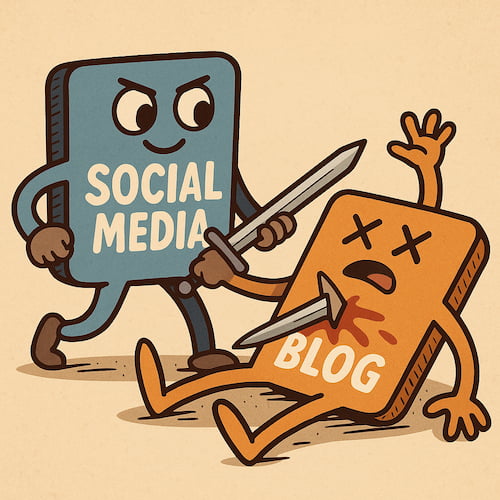|
||||
|
The Second Death of BlogsAnyone reading this probably pines for the days of blogs. They were the vibrant hubs of opinion, the personal diaries turned public, and the primary colors of the old internet. But the landscape has shifted, not once, but twice. This is the story of the double demise of blogging, caused by the ever-changing currents of online communication. The Dawn of Democratized Publishing: From Code to CMSIn the early days of the World Wide Web, publishing was a specialized skill. If you wanted to share your thoughts online, you needed a grasp of HTML, an understanding of servers, and a patience for clunky interfaces. This barrier to entry meant that the first wave of online voices often belonged to the tech-savvy. Then came a revolution in the form of CMSes. The arcane world of web publishing opened up. Platforms emerged that allowed individuals to create, manage, and publish content without needing to write a single line of code. The advent of open-source CMSes, like WordPress, further democratized this space. Anyone with a computer and an internet connection could, in theory, have a global platform. Blogs flourished, covering every conceivable topic, from personal journeys to in-depth analyses of current events. Publishing was no longer the domain of a select few; it belonged to everyone. And of course, programmers were part of this. The Golden Age of RSS and the "First Death"As blogs proliferated, a new challenge arose: how to keep up with them all? The answer for a significant, influential slice of the internet-savvy population was RSS readers. And king among them was Google Reader. Before the dominance of social media, RSS readers were the personalized newspapers of the "in the know." Instead of browsing countless individual websites, users subscribed to feeds, and new posts from their favorite blogs landed directly in their reader. Google Reader, in particular, became a beloved tool, not just for its user-friendliness but also for its social features – the ability to share interesting posts with a network of like-minded individuals. It was a curated, text-rich environment where ideas and discussions sparked. There were even Trackbacks, a way to reply to someone else's post. To even think that this was a thing, now looking back, in 2025... Programming blogs were a big part of this as well. I remember early in my career reading Daily JS, a blog that posted the latest in JavaScript open source projects. I remember getting my projects talked about there a couple of times, and how that gave me an in with job interviews. Then, in 2013, Google pulled the plug on Reader. For me, this was the "first death of blogs." The primary, streamlined way an engaged audience consumed blog content vanished. While alternative RSS readers existed, none had the widespread adoption, ease of use, or the subtle social ecosystem that Google Reader had cultivated. The firehose of blog content suddenly had a kink in it. The Rise of Social Media: A New Town Square with Different RulesAlmost concurrently with Google Reader's demise, social media platforms were experiencing an explosive ascent. Twitter, Facebook, and others offered a different kind of online interaction – faster, shorter, and more immediate. The lengthy, considered opinions often found in blog posts began to feel cumbersome in a world of 140 (and then 280) characters. Instead of crafting a detailed blog post, individuals could fire off a quick take on Twitter. Discussions that might have unfolded in the comments section of a blog migrated to Facebook threads. Social media became the new de facto town square, and its architecture favored brevity and rapid-fire engagement over the more reflective nature of blogging. Blogs didn't disappear entirely, but their central role in disseminating news and opinions began to wane. They became less the primary source and more the secondary, deeper-dive resource, often discovered through social media links. The "Second Death": When the Algorithm Turns InwardThis brings us to the more recent, and perhaps more insidious, shift – the "second death of blogs." Social media platforms, once conduits for sharing links to external content like blog posts, have increasingly changed their algorithms to prioritize native content and user retention. The new mandate is to keep users on the platform. Sharing an external link, like a blog post, often means that content is de-prioritized by the algorithm. The reach of such posts diminishes, making it harder for bloggers to find an audience through these once-fertile channels. Furthermore, the nature of engagement itself has been subtly reshaped. Algorithms often favor content that elicits strong, quick reactions – the kind that can be easily signaled with an emoji or a "reaction thumbnail." Nuanced discussion and thoughtful communication, the traditional hallmarks of blog comment sections and the communities around them, take a backseat to attention-grabbing, often polarizing, content. The algorithm, in its quest for maximum engagement, can inadvertently filter out the very depth and thoughtfulness that blogs once championed. This has, of course, had a profound impact in the programming space. Where rising to the top of Hacker News and the flurry of social media commentary that coincided was once the pinnacle of hot-take success, this has almost all be vanished from our community. So, Where Do We Go From Here?The "second death of blogs" paints a challenging picture for those who value in-depth content and direct lines of communication. While social media's algorithmic grip tightens, is there a path forward for publishers and readers seeking a richer, less mediated experience? Perhaps the answer lies in a tool that predates even the blog itself: email. The rise of newsletters and mailing lists offers a tantalizing prospect – a way to deliver content directly, to be consumed at leisure, and to foster a direct relationship between creator and audience, away from the ephemeral tides of the social feed. I'll be exploring this resurgence in a future post. |
||||
|
||||
A Note from the Editor
Welcome to your weekly source for insights into the ever-evolving world of technology. Each edition aims to explore a variety of topics, from the latest breakthroughs in software development to cutting-edge industry innovations. We're passionate about sharing knowledge that informs, inspires, and sparks new ideas. Stay Curious, |
||||
Join Our Mailing List!Don't miss out on future insights. Subscribe to get our latest updates directly in your inbox. |
||||
|
||||

